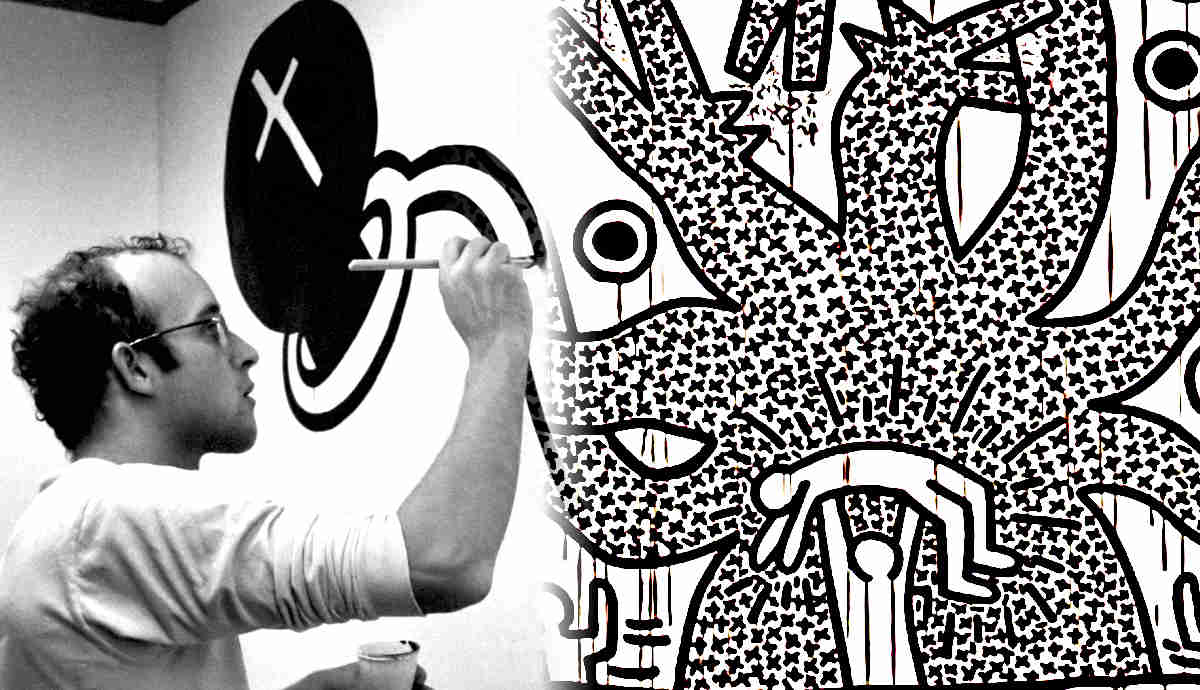
Keith Haring, born on May 4, 1958, was an artist and activist who was part of the thriving alternative art scene of New York in the 1980s. With innovative energy and an undying passion for pop culture and political unrest, Haring made an everlasting mark on the history of art.
While you may recognize his memorable style, you may not know much about the man himself. So, here are 7 intriguing and important facts to know about Haring.
1. Haring’s Art Was Inspired by Graffiti.

In New York during the 1980s, graffiti art inspired many artists of the time, whether they participated in the graffiti movement itself or taking bits of it to use in their art of a more traditional form like drawing and painting.
Haring would use chalk to decorate empty poster spaces in New York City subway stations. The goal was to make his art accessible to more people, opening up interest in his style to people of all cultural and socioeconomic backgrounds.
When people would walk by his drawings, it would increase the excitement for his paintings and exhibitions. He was arrested multiple times for vandalism.
2. Haring Was Openly Gay

Even though it was suspected that many artists of the legendary 1980s New York scene were gay, Haring is unique because he would openly share this fact with the world – something not everyone was comfortable doing.
He represented the numerous hardships LGBTQ people faced during the time in his artistic work. One of his posters Ignorance = Fear notes the challenges people with AIDS continuously faced and he worked tirelessly to reach as many people as possible to express the importance of AIDS education.
3. Haring Was Inspired by the Music and Surroundings of the Time

The way Haring worked was just as fun and quirky as the result. He would often listen to hip-hop music while he painted, stroking the brush to the beat. You can see the rhythmic lines in his work that give the pieces a kind of musical energy that is unique to the Haring style.
Also, many of his paintings were done on vinyl tarpaulin, which not only works as a canvas. It was often used by breakdancers as a surface for their street performances. Haring had fun with his work and was both a creator and a product of his 80s environment.
4. He Collaborated with Other Famous Artists of the 1980s
The 80s created the now-famous, New York artistic underground scene, which harbored a multifaceted group of prolific artists on the cusp of stardom and mainstream success. From other painters to musicians and fashion designers, Haring was part of this incredible community of people.
Haring frequently worked alongside artists Andy Warhol and Jean-Michel Basquiat, as well as fashion moguls Vivienne Westwood and Malcolm McLaren. He worked on a particularly interesting project with Grace Jones where he painted her body with graffiti for her musical performances, and he made a cameo in her music video I’m Not Perfect (But I’m Perfect For You), where his signature style can be seen. Haring was also close friends with Madonna. Haring took Warhol as his plus one to her wedding.
5. Haring’s Art Was a Commentary on Social and Political Issues.

Haring is known for his vibrant, colorful art, much of which was in response to political and social issues of the time, not only in America but around the world, including apartheid, the AIDS epidemic, and rampant drug abuse.
The topics within his art create a stark contrast from the fun shapes and bursts of color he used. One of his most famous pieces Crack is Wack refers to the cocaine epidemic that took hold of New York City in the 80s. At first, it seems like a silly cartoon, but a second look makes it clear that the subject matter is serious.
In 1886, Haring was invited to paint the Berlin Wall. On it, he completed a mural symbolizing the dream of unity between East and West Germany. Of course, it was destroyed when the wall came down in 1989, but this anecdote highlights how politically involved Haring was.
6. His Work Drew the Attention of Children and Adults

Even though a lot of Haring’s work incorporated commentary on some very “adult” themes, he also loved working with children and was always inspired by the natural creativity, sense of humor, and innocence of childhood. To celebrate the 100th anniversary of the Statue of Liberty in 1986, he painted a mural for the Liberty Tower in Battery Park with the help of 900 young people, asserting that our youth had an important place in our communities.
Haring would also collaborate with charities to support young people, painting many murals at children’s hospitals to amuse the sick children who would pass through.
7. He Created The Keith Haring Foundation in 1989

Sadly, Haring was diagnosed with AIDS in 1988. He used his prominence as a successful artist to raise awareness for the epidemic through his work before eventually setting up The Keith Haring Foundation in 1989.
The Foundation continues to help provide funding and support to AIDS research, charities, and educational programs. For more information on how you can show your support, visit The Keith Haring Foundation website or check out The Elizabeth Glaser AIDS Foundation, a partner of The Keith Haring Foundation.
Unfortunately, Haring passed away from AIDS-related complications on February 16, 1990, at only 31 years old. Haring’s influential, unique, and undeniably recognizable work can be seen at Tate Liverpool, Guggenheim New York, the Museum of the City of New York, and elsewhere.
For a full list of current Haring exhibitions worldwide, visit the Keith Haring website.







